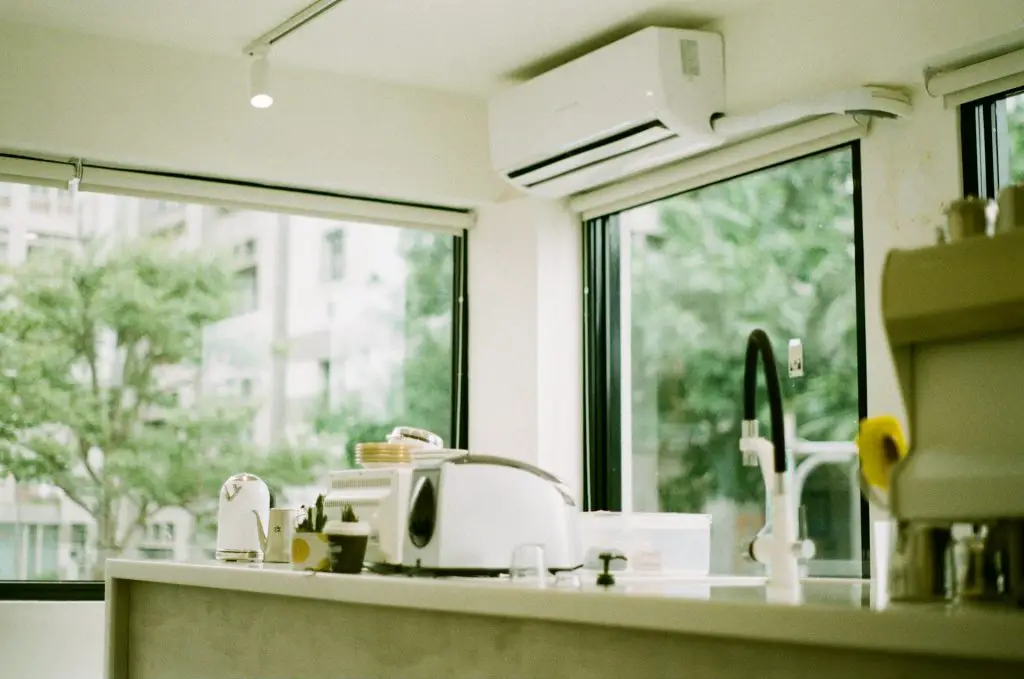A well-designed kitchen isn’t just about appliances and layout, it’s about how the air moves. When HVAC and ventilation work together to keep heat, smoke, and odors under control, the kitchen instantly feels more inviting. Before diving into the details, here’s how airflow quietly shapes your motivation to cook.
Why Is Ventilation Important in the Kitchen for Your Desire to Cook
Good kitchen ventilation changes the entire mood of the kitchen. It’s also one of the most overlooked parts of the home’s HVAC system, because when the air stays clean, temperatures don’t spike every time you sauté something, and odors don’t linger, the kitchen stops feeling like a chore zone and starts feeling like a place you actually want to be. It reduces heat buildup so you’re not sweating over the stove, prevents the smoke haze that makes the space feel cramped, and creates a fresh, energizing airflow instead of a stuffy atmosphere, the kind of difference strong kitchen cooking ventilation is designed for.
When the air is light and breathable, cooking feels easier, you can stay in the kitchen longer, and you’re more likely to experiment instead of rushing through meals. Ventilation isn’t just about clean air, it shapes how you feel in the space. When the air moves the way it should through a reliable kitchen ventilation system, the kitchen feels lighter, calmer, and more “yours,” so you can focus on flavor rather than fumes.
Great ventilation turns cooking from “Let me hurry and finish so the house doesn’t smell” into “I actually want to hang out in here.” It’s the difference between a kitchen you simply use and a kitchen you genuinely enjoy, more like a creative studio than a hot, smoky workspace supported by proper kitchen ventilation and a well-balanced HVAC system.
How Kitchen Cooking Ventilation Impacts Comfort and Safety
Ventilation in the kitchen does two jobs at once: protecting you physically and making your space more comfortable to use. It also plays a quiet but important role in how your home’s HVAC system manages heat and airflow, removing smoke, steam, and grease particles that cling to your cabinets, keeps humidity balanced so the room doesn’t feel muggy, and stops strong cooking odors from sticking around. At the same time, it manages hidden pollutants and keeps overall kitchen air quality stable and safe.
It handles the invisible stuff, gas stove byproducts like carbon monoxide and nitrogen dioxide, microscopic grease, and excess moisture that can lead to mold. Poor airflow even makes appliances work harder and run hotter, which adds unnecessary wear, underscoring why dependable kitchen cooking ventilation matters.
It’s not just “nice to have.” Good ventilation is essential to a healthy, safe home. It protects your home the same way good boundaries protect your sanity: keeping the bad stuff out and making the space livable. With proper airflow, the heavy post-cooking thickness disappears, smells don’t settle into furniture, and the space simply feels lighter. A ventilated kitchen ages more gracefully, stays cleaner longer, and genuinely feels healthier to be in, comfort, safety, and long-term maintenance wrapped into one system most people ignore.
Kitchen Ventilation Tips for Spotting Poor Kitchen Air Quality
When the air feels heavy or polluted, people instinctively avoid spending time in the kitchen. Lingering food smells, smoke or haze when you fry, a greasy film on cabinets, condensation on windows, and that stale, stuffy odor even when the space is clean all point to the same issue: declining kitchen air quality.
Irritation like coughing, watery eyes, or a scratchy throat during cooking, along with a kitchen that heats up fast and cools down slow, are also classic ventilation symptoms. These are the signs most homeowners overlook until they upgrade their kitchen ventilation system or improve basic kitchen cooking ventilation and immediately feel the difference.
Most people don’t connect these problems to airflow, but once ventilation improves, the difference is immediate. People don’t skip cooking because they lack time; they skip because the space feels draining. That heaviness you notice after frying, the stubborn film on surfaces, musty pockets of air, smells that take over the house, and irritation that only happens while cooking all send the same signal: this space is uncomfortable. And discomfort kills the desire to cook.
How to Improve Kitchen Ventilation Without Remodeling
You have more options than you might think, and none require tearing open walls. Upgrading hood filters with charcoal and high-quality mesh, using a stronger ductless hood if ductwork isn’t possible, and adding a window exhaust fan all make a noticeable difference to daily kitchen ventilation. Opening two windows or pairing a window with a portable fan improves cross-breeze, and even a small crack under the door can boost airflow more than people expect.
A ceiling fan helps prevent heat pockets, and placing a portable HEPA purifier near the cooking zone catches ultrafine particles before they drift into the rest of the home, an easy way to support kitchen air quality. Sealing gaps around the stove keeps grease from settling in hidden spots.
These small changes stack up fast, true “micro-upgrades with macro impact.” Simple moves like pushing air out a window instead of just circulating it, running the hood before and after cooking, using pan lids to control steam, clearing clutter so air can move freely, and adding a small window vent panel give you cleaner air without touching a single wall or replacing your kitchen ventilation system.
Exhaust Fan Kitchen Recommendations for Better Airflow
The systems that actually move the needle are the ones that match both how you cook and the geometry of your kitchen. Ducted range hoods, which pull air out of the house, remain the most effective option and work especially well for frequent cooks, heavy frying, and gas stoves, a strong foundation for any ventilation fan for kitchen airflow. Ductless or recirculating hoods are less powerful but useful in apartments or older homes when ductwork isn’t possible.
Downdraft ventilation can work for islands, though it’s less effective with tall pots. Ceiling-mounted island hoods offer high airflow and a wide capture area for open, spacious kitchens, while window or wall-mounted exhaust fans are simple, affordable, and surprisingly powerful solutions for small or older spaces.
The real answer homeowners rarely hear is that the “best” system depends entirely on cooking habits and layout. Frequent frying calls for a high-capture ducted hood with deep baffles. Open-concept kitchens usually need a wider or ceiling-mounted hood. Apartment setups benefit from a strong recirculating hood with good carbon filtration. And some tiny kitchens see better performance from a basic window exhaust fan than from many entry-level ductless hoods, a reminder that kitchen ventilation isn’t one-size-fits-all.
Choosing a Ventilation Fan for Kitchen Layouts of Any Size
Here’s a practical breakdown based on CFM needs, but also on how air actually moves through the kitchen. Small kitchens under 150 sq ft usually do well with a 250-350 CFM hood, a window exhaust fan for quick odor removal, or a compact ductless hood with charcoal filters. In tight spaces, a hood that’s wide but shallow captures more without overwhelming the room, and low-profile under-cabinet hoods or window exhaust fans help remove heat and moisture fast, classic uses of a compact ventilation fan for kitchen comfort.
Medium kitchens in the 150-300 sq ft range typically need a 350-500 CFM hood. Island setups benefit from island hoods, and moisture-heavy cooking often works best with a hood plus a wall or side-wall exhaust fan. Standard layouts stay comfortable with that same 350-500 CFM range paired with proper airflow direction from a well-fit kitchen ventilation system.
Large kitchens over 300 sq ft, especially open-concept spaces, need stronger systems, usually 600-900 CFM or higher. Deep canopy-style hoods or ceiling-mounted options help because air drifts more in large, open rooms, and professional-grade blowers can support heavy cooking.
In apartments or rentals, a high-efficiency ductless hood, a portable HEPA purifier near the stove, and a window fan blowing air out during cooking can all work together without altering the space or compromising kitchen cooking ventilation.
Ultimately, it’s not just the CFM, it’s how the hood’s shape, height, and placement match the path the air naturally wants to take.
Air Purifier for Kitchen Spaces: How It Supports Ventilation
An air purifier can’t replace proper kitchen ventilation, but it can help reduce what your hood misses, especially ultrafine particles and lingering odors. This is where it supports overall kitchen air quality rather than acting as a full ventilation solution. Look for True HEPA (H13 or better) to capture smoke, PM2.5, and grease particles, plus a solid activated carbon filter for odor control.
Think of it as your cleanup crew, not your main ventilation system. A purifier handles the smoke particles small enough to slip past the hood, odors that stick around longer than they should, and any air that drifts into open living areas. Choose one with True HEPA, a substantial carbon filter, a high CADR, and a washable pre-filter so grease doesn’t overwhelm it, especially helpful in kitchens where the kitchen ventilation system is older or limited.
Is It Illegal to Work in a Kitchen Without Ventilation?
In residential kitchens, not having a vent isn’t illegal in most regions. Still, building codes often require either an exhaust hood vented outdoors or a recirculating hood with proper filtration, along with minimum airflow standards that vary by state or country. During remodels, local code may require a properly ducted hood, especially with gas stoves, since some states now mandate mechanical ventilation for safe combustion and moisture control, all part of defining a compliant kitchen ventilation system.
Commercial kitchens are a completely different ballgame. Ventilation isn’t optional; it’s legally tied to fire codes, safety, and health regulations. These spaces typically require Type I hoods for grease-producing appliances, make-up air to replace what’s exhausted, fire suppression systems, and strict CFM and ducting requirements. Operating a commercial kitchen without proper ventilation can result in fines, shutdowns, or the loss of permits.
The distinction is simple: residential ventilation is about meeting basic safety and building code minimums, while commercial ventilation is a mandatory system that keeps the business legally operational.
Kitchen Ventilation Tips That Boost Your Motivation to Cook
People avoid cooking when the kitchen feels hot, smelly, or hard to breathe in. Turning the hood on before the pan heats up, running it on low while prepping, and keeping filters cleaned monthly all make airflow feel instantly better, simple habits that dramatically improve kitchen cooking ventilation. Using lids when steaming or boiling, cooking near an open window, and combining a ceiling fan with the hood help control steam, heat, and odors.
A portable purifier during and after cooking catches what the hood misses, supporting overall kitchen air quality, and wiping down grease-prone areas keeps that “sticky air” from building up. Lighting matters more than people think, bright, warm light makes the space feel fresher, while dark and stuffy kills motivation.
Keeping the stove area uncluttered helps air move, and even a small herb plant near the window adds natural freshness. These small touches pair perfectly with a well-tuned kitchen ventilation system.
The secret is making the kitchen feel better, not just function better. When the space feels airy, bright, and breathable, it naturally invites you back in and makes cooking far more enjoyable.

